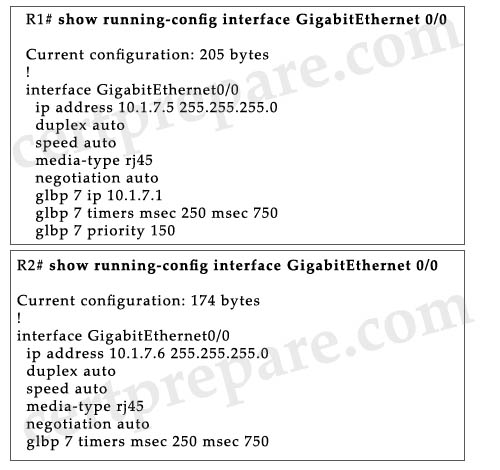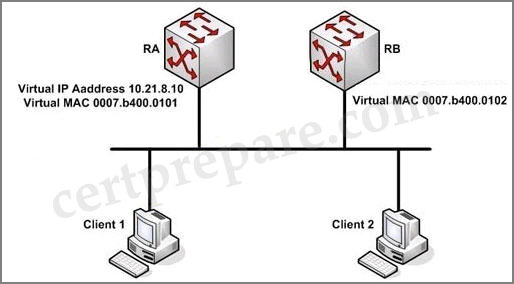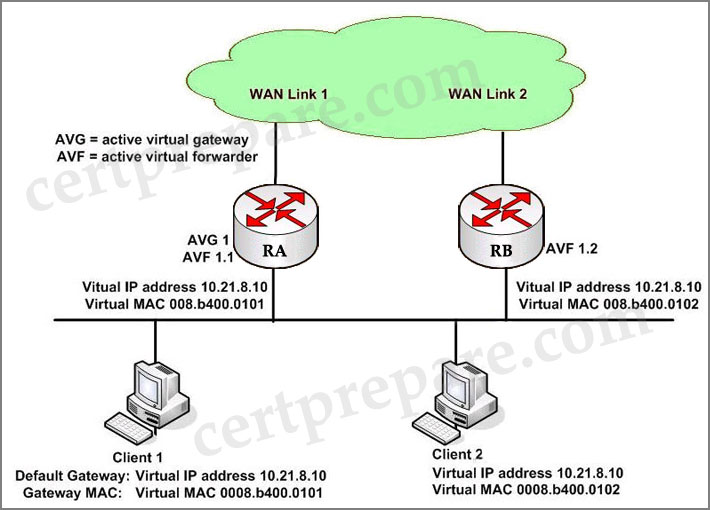GLBP Questions 2
Here you will find answers to Gateway Load Balancing Protocol (GLBP) Questions – Part 2
If you are not sure about GLBP, please read our GLBP tutorial.
Question 1
Refer to the exhibit. What statement is true based upon the configuration of router R1 and router R2?

A. Router R2 will become the master for Virtual Router 1, and router R1 will become the backup for Virtual Router 2.
B. Router R1 will become the master for Virtual Router 1, and router R2 will become the backup for Virtual Router 2.
C. Router R1 will become the active virtual gateway.
D. Router R2 will become the active virtual gateway.
E. The hello and hold timers are incompatible with OSPF type 5 LSAs.
F. The hello and hold timers are incompatible with multi-homed BGP.
Answer: C
Explanation
R2 is configured with the “priority” command so it will use the default priority value of 100, which is smaller than that of R1 (150) -> R1 will be active virtual gateway.
Question 2
Which type of scheme describes the default operation of Global Load Balancing Protocol (GLBP)?
A. Per host using a round robin scheme
B. Per host using a strict priority scheme
C. Per session using a round robin scheme
D. Per session using a strict priority scheme
E. Per GLBP group using a round robin scheme
F. Per GLBP group using a strict priority scheme
Answer: A
Explanation
GLBP load sharing is done in one of three ways:
Round-robin load-balancing algorithm: Each router MAC is used sequentially to respond to ARP requests. This is the default load balancing mode in GLBP and is suitable for any number of end hosts. ->
Weighted load-balancing algorithm: Traffic is balanced proportional to a configured weight. Each GLBP router in the group will advertise its weighting and assignment; the AVG will act based on that value. For example, if there are two routers in a group and R1 has double the forwarding capacity of router B, the weighting value of router A should be configured to be double the amount of R2.
Host-dependent load-balancing algorithm: A given host always uses the same router.
Question 3
You are a network technician, study the exhibit carefully. Both routers are configured for the Gateway Load Balancing Protocol (GLBP). Which statement is true?

A. The default gateway address of each host should be set to the virtual IP address.
B. The default gateway addresses of both hosts should be set to the IP addresses of both routers.
C. The hosts will have different default gateway IP addresses and different MAC addresses for each.
D. The hosts will learn the proper default gateway IP address from Router RA.
Answer: A
Question 4
You work as a network technician at Technical Corporation. Your boss is interested in GLBP. Study the network topology exhibit carefully. Which three statements accurately describe this GLBP topology? (Choose three)

A – If RA becomes unavailable, RB will forward packets sent to the virtual MAC address of RA.
B – RA is responsible for answering ARP requests sent to the virtual IP address.
C – If another router were added to this GLBP group, there would be two backup AVGs.
D – RA alternately responds to ARP requests with different virtual MAC addresses.
Answer: A B D
Explanation
If RA fails, the GLBP protocol informs RB to replace the AVG that is down. The new AVG (in this case RB) will forward the packet sent to the 0008.b400.0101 virtual mac address, so the client sees no disruption of service nor does it need to resolve a new MAC address for the default gateway. -> A is correct.
RA, which is the AVG, replies to the ARP requests from clients with different virtual MAC addresses, thus achieving load balancing -> B is correct.
RA is elected as the AVG and RB is elected as the standby virtual gateway. If another router is added to this GLBP group, it will become a backup AVG -> there is only one backup AVG -> C is not correct.
“RA alternately responds to ARP requests with different virtual MAC addresses” this is the way GLBP provides load balancing over multiple routers (gateways) using a single virtual IP address and multiple virtual MAC addresses. Which MAC address it returns depends on which load-balancing algorithm it is configured to use -> D is correct.


